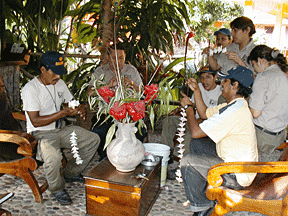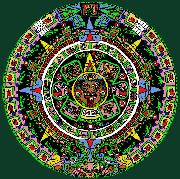I began my adventure descending down a steep
grassy hill to the pebbled banks of the Rio Oxolotan. There, I and my
fellow travelers took turns boarding a small launch that brought us to a
landing about 550 yards down on the other side of the river. The river,
this late in the day, ran quiet but fast.
After reaching the landing, we ascended up a
steep 45-degree incline through the jungle. By this time the sun had set
and the darkness of the jungle enveloped us like a shroud. Huge plants
surrounded us on all sides and strange sounds emanated from the
darkness. By the time we reached Kolem Jaá’s tiny reception palapa, I
felt hot, sweaty and oh so tired from the strenuous hike on an empty
stomach.
Activities at Kolem Jaá
Luis Gomez, director of the camp, explained the available activities
as we dined on a Spartan meal of a beef, tomatoes, onion and rice mix,
washed down with cold mojata milk under the pale lights of the
dining palapa. Of the several activities the camp offered, he seemed the
most excited about the Canopy Tour, in which we would climb to a
platform in the canopy of trees, get strapped into harnesses attached to
a cable, and then swing from tree to tree through 11 platforms. Needless
to say, I opted out of that activity then and there. Gomez made a point
of saying that Kolem Jaá’s canopy tour was not only the longest but
also the safest in Latin America. I held to my decision.
Another activity, the Commando Trail, sounded
almost as intimidating. Besides swinging in the canopy, then repelling
down a jungle waterfall, participants needed to cross air tubes in an
enormous pond, go through several narrow passes, use a zip line with a
30-degree incline, and finally cross a special bridge called a paseo
del soldado, which involved walking along a lone cable across a
ravine. Though wires and nets were supposed to prevent any dangerous
falls, this wasn’t my idea of fun.
Finally, Gomez told us about the mysterious
Cave of the Blind Sardines. Now he got my attention. He said we’d have
to climb down into a grotto in the cave, in which bacteria thrive on the
sulfur that bubbles up from underground. He noted that the slime-covered
the rocks in the cave can be slippery. So I tentatively opted to visit
the cave.
A Jungle Ecological Center
In spite of Gomez’s emphasis on these adventure-type activities,
Kolem Jaá is actually a privately funded ecological center designed to
restore some of the Tabascan jungle, 95 percent of which has
disappeared. The camp’s owner formerly operated a cattle ranch on the
property, but the government persuaded him that growing hardwood trees
on the same acreage that supported his cattle could be much more
profitable, and that he could harvest decorative plants to sell at high
prices while the forest grew to maturity.
So in July 2002, Kolem Jaá, which means great
water in the Chol language as it’s named after a giant waterfall on
the property, opened as part of Vida y Desarrollo (Environmental
Protection Program), a project established to encourage sustainable
tourism, with a goal to create a natural world of adventure in harmony
with nature. Here locals could engage in organic agriculture, operate
tropical nurseries, cultivate bamboo and Mutusay hanging roots,
establish a butterfly sanctuary, operate a white-tailed deer breeding
farm, and work in workshops, creating crafts of rattan, bamboo, and
leather. Through this government program, local compesinos could earn
more and provide themselves with a better life by catering to tourists.
The entire complex, set on almost 67 acres 90
minutes from the city of Villahermosa in southern Tabasco, lies deep in
the jungle, criss-crossed by manicured serpentine trails laid with cement
stepping stones a good distance apart, seemingly by the Jolly Green
Giant. With shorter legs, I found myself leaping from stone to stone,
like a gazelle fleeing a predator.
The Camp
The camp, which includes 10 cabanas with two rooms each and a tent
area with a dozen two-man tents with cots, took seven years to create.
My cabana room was quite luxurious and comfortable with all modern
conveniences, including a full tile shower, complete with resident
spiders. Workers had painted each in tropical colors to blend in with
the surroundings. And I could sit in a leather chair out on my small
veranda and listen to the jungle sounds while I sipped freshly-made
coffee from my room’s coffeemaker.
The emphasis here is on luxurious adventure for
those seeking to put some excitement in their hum-drum lives. But Kolem
Jaá offered so much more–for me, a chance to get to know the jungle
up close and personal.
After four years of reforestation, planting
native trees such as cedar, mahogany, macha blanca (whitewood), mango,
cypote, and ceiba, workers began building the Commando Trail and the
Tlalucalupe Trail to the Cave of the Blind Sardines. During the sixth
year, they began laying out the campsite and cabanas and constructing
the Canopy.
A camper at heart, I found the only
disadvantage to be the access to the place, over a steep stepping-stone
trail with even steeper steps up and down to the river, all in the
Tabasco heat and humidity. Of course, after some investigation on my
own, I found a much easier way to get to the camp by going up river.
However, the water was too shallow there for the launch to get close to
shore.
 The
next morning, after a breakfast of fresh fruit smothered in strawberry
yogurt and granola, followed by scrambled eggs and refried beans and
lots of coffee, I waved the others off as they headed for the Canopy
Tour and began my trek into the jungle. The resident pericos
(parrots)–who I dubbed the "Tres Amigos" –chimed in trying
to get my attention with their shrill screeching as they sat on perches
under the reception palapa. Meanwhile, the staff strung flowers on wires
for colorful necklaces in the cool of the early morning.
The
next morning, after a breakfast of fresh fruit smothered in strawberry
yogurt and granola, followed by scrambled eggs and refried beans and
lots of coffee, I waved the others off as they headed for the Canopy
Tour and began my trek into the jungle. The resident pericos
(parrots)–who I dubbed the "Tres Amigos" –chimed in trying
to get my attention with their shrill screeching as they sat on perches
under the reception palapa. Meanwhile, the staff strung flowers on wires
for colorful necklaces in the cool of the early morning.
A Jungle Paradise
Not far from the shrieking parrots, I noticed a small sign
signifying the entrance to the botanical garden. However, it was
difficult to distinguish the garden from the surrounding jungle, as the
two were fast merging into one green, leafy mass.
Water rushed down a jungle stream, as I gazed
at a giant Bastion Del Rey (the Staff of the King), a floral
wonder of nature, looking like a large, red pine cone full of seeds
sitting atop a base of broad pint petals. Nearby, a towering giant
Schefflera tree blocked out the sun’s rays while large leaf tropical
plants interrupted my path. Banana trees, palms, and all sorts of
flowers I had never before seen all had identification markers.
The constant da-ta-da-ta-da-ta of
insects was the only sound, save for my footfalls on decaying jungle
matter. Suddenly, I heard the shrill cries of wild peacocks and turkeys
ringing through the trees as I stopped to admire several bright red and
yellow Heliconia rostrata blossoms–a member of the same family
as Bird-of-Paradise plants, with flowers that hang in an inverted
triangle off of a spine. Further along, I stopped to watch as a column
of jungle ants marching up and down a tree trunk gathering food.
As I walked into the jungle’s depths, it felt
like I had entered an old tapestry, in some places darkened from lack of
light, and in others faded with age, but all rich in varied shades of
green highlighted by bright spots of colorful flowers. At times I couldn’t
see the sky in there, but the sunlight created patterns as it shown down
through the foliage. The vines hanging from the trees gave me a creepy
feeling, as if I were going to be swallowed up at any moment. The air
was still and moist. Howler monkeys flitted from tree to tree. If I
stood still long enough, I could catch a glimpse of one here and there.
They made a peculiar sound–not unlike howling–followed by a smacking
kiss.
I wondered through the jungle alone for several
hours, eventually stopping by a large palapa that acted as the camp
meeting place. Ducks and geese waddled around out back as a peacock
strutted amidst them trying to scare them. Soon a column of humans–my
fellow campers, each in harness–returned from swinging through the
trees just long enough to down a refreshing drink before we all took off
for the Cave of the Blind Sardines.
Cave of the Blind Sardines
The hike to the cave–over a somewhat scenic trail through the
forest that took us past the original hacienda on the property, now a
local museum–was a bit easier than I expected. Striking vistas along
the way provided ample opportunities to see out over the countryside and
jungle. We even stopped to investigate some unique mushrooms growing
along the trail.
We knew we were close when we noticed the water
in a jungle stream had turned a cloudy light blue color similar to that
of fabric softener. Not far ahead, lay the cave’s rocky entrance.
These blind sardines–I almost expected to see hundreds of tiny fish
wearing tiny shades as if in a Ray Charles look-alike contest–swim in
this water. Carbon dioxide, produced by the bacteria from a hoard of
spiders who live in it, fills the cave air. Nearly 5,000 bats of three
varieties also call the cave home. I could already tell this wasn’t an
especially hospitable place.
But as we donned helmets with headlights and
started down into the cool, damp cave, it

